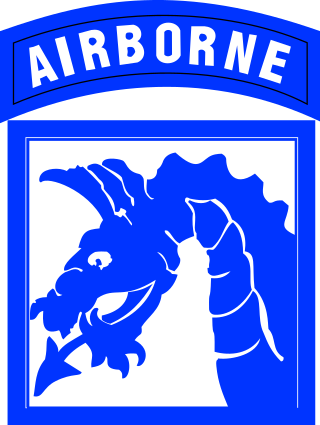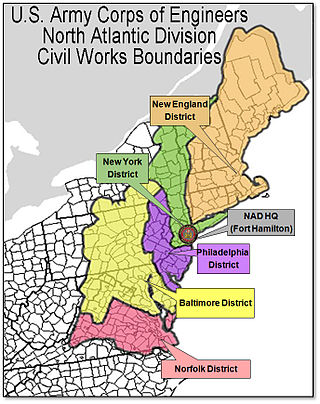Related Research Articles

Harold Gregory Moore Jr. was a United States Army lieutenant general and author. He was awarded the Distinguished Service Cross, the U.S. Army's second-highest decoration for valor, and was the first of his West Point class (1945) to be promoted to brigadier general, major general, and lieutenant general.

The XVIII Airborne Corps is a corps of the United States Army that has been in existence since 1942 and saw extensive service during World War II. The corps is designed for rapid deployment anywhere in the world and is referred to as "America's Contingency Corps." Its headquarters are at Fort Liberty, North Carolina.

Basil Leonard Plumley was a career soldier and airborne combat infantryman in the United States Army who rose to the rank of command sergeant major. As a combat veteran of World War II and the Vietnam War, he is most noted for his actions during the Battle of Ia Drang in Vietnam.

First Army is the oldest and longest-established field army of the United States Army. It served as a theater army, having seen service in both World War I and World War II, and supplied the US army with soldiers and equipment during the Korean War and the Vietnam war under some of the most famous and distinguished officers of the U.S. Army. It now serves as a mobilization, readiness and training command.

Sixth Army is a theater army of the United States Army. The Army service component command of United States Southern Command, its area of responsibility includes 31 countries and 15 areas of special sovereignty in Central and South America and the Caribbean. It is headquartered at Fort Sam Houston.

Fort Moore is a United States Army post near Columbus, Georgia, adjacent to the Alabama–Georgia border. Fort Moore supports more than 120,000 active-duty military, family members, reserve component soldiers, retirees and civilian employees on a daily basis. As a power projection platform, the post can deploy combat-ready forces by air, rail, and highway for their designated mission. Fort Moore is the home of the United States Army Maneuver Center of Excellence, the United States Army Armor School, United States Army Infantry School, the Western Hemisphere Institute for Security Cooperation, elements of the 75th Ranger Regiment, the 1st Security Force Assistance Brigade, and other tenant units.
The Military Intelligence Hall of Fame is a hall of fame established by the Military Intelligence Corps of the United States Army in 1988 to honor soldiers and civilians who have made exceptional contributions to military intelligence. The hall is administered by the United States Army Intelligence Center at Fort Huachuca, Arizona.
Edward "Eddie" Crook Jr. won a gold medal for the United States as a boxing teammate of Muhammad Ali in the 1960 Summer Olympics. Crook was also a member of Omega Psi Phi fraternity.

The North Atlantic Division of the U.S. Army Corps of Engineers is one of the eight permanent divisions within the Corps.

The 13th Sustainment Command (Expeditionary)—the "Lucky 13th"—is a U.S. Army modular sustainment command which serves as a forward presence for expeditionary operations for a theater, or in support of a regional combatant commander. Expeditionary sustainment commands (ESC), such as the 13th, synchronize distribution of supplies and services within their operational areas and provides distribution oversight. Formed at Fort Cavazos, Texas when the 1st Logistics Command deployed to Vietnam, the organization then known as the 13th Support Brigade was initially responsible for the training of technical services units to assume combat service support missions in Southeast Asia.

Fourth United States Army was a field army of the United States Army between 1932 and 1991.

The United States Army North (ARNORTH) is a formation of the United States Army. An Army Service Component Command (ASCC) subordinate to United States Northern Command (NORTHCOM), ARNORTH is the joint force land component of NORTHCOM. ARNORTH is responsible for homeland defense and defense support of civil authorities. ARNORTH is headquartered at Fort Sam Houston, Texas. Redesignated ARNORTH in 2004, it was first activated in early January 1943 as the United States Fifth Army, under the command of Lieutenant General Mark W. Clark.
The De Fleury Medal, an award of the US Army Engineer Association, was named in honor of François-Louis Teissèdre de Fleury, a French Engineer in the Continental Army.

The Commandant of the United States Army Command and General Staff College is the highest-ranking official at the United States Army's Fort Leavenworth, Kansas, installation. The position is similar to the West Point Superintendent and is roughly equivalent to the chancellor or president of an American civilian university. Since 1976, the commandant has been a Lieutenant General and is also in charge of the United States Army Combined Arms Center which includes other training organizations at Fort Leavenworth.
The following Union Army units and commanders fought in the Battle of the Crater of the American Civil War. The Confederate order of battle is listed separately.
The following units and commanders fought in the Carolinas campaign of the American Civil War. The Union order of battle is listed separately. Order of battle compiled from the army organization during the campaign.

The 108th Training Command (Initial Entry Training) is a United States Army Reserve unit headquartered in Charlotte, North Carolina. At its activation, the unit was designated as the 108th Airborne Division, but in 1952 was redesignated the 108th Infantry Division. In 1956, the division was again reorganized, this time to the designation as the 108th Division (Institutional Training). Under the U.S. Army Reserve Transformation of 2005, the 108th was reorganized to is current structure as the 108th Training Command (Initial Entry Training (IET)). The command is currently one of the largest in the Army Reserve, commanding and coordinating 9,000 soldiers.

The 107th Cavalry Regiment, Ohio Army National Guard, is a parent regiment under the U.S. Army Regimental System, with headquarters at Hamilton, Ohio. It currently consists of the 2nd Squadron, 107th Cavalry Regiment, part of the 37th Infantry Brigade Combat Team (BUCKEYE), Ohio National Guard located throughout southwest Ohio.

The United States Army Central, formerly the Third United States Army, commonly referred to as the Third Army and as ARCENT, is a military formation of the United States Army that saw service in World War I and World War II, in the 1991 Gulf War, and in the coalition occupation of Iraq. It is best known for its campaigns in World War II under the command of General George S. Patton.

Pershing House has been the residence of the commanding officers of Fort Sam Houston since 1881. Located in Bexar County, San Antonio, Texas, the military post is currently part of Joint Base San Antonio. The house was added to the National Register of Historic Places listings on 30 July 1974. After the Texas annexation to the Union in 1845, the United States Army became a steady presence in what was then designated the Department of Texas, providing a line of defense during both the 1846–1848 Mexican–American War, and the Texas–Indian wars that ended with the 1875 surrender of Comanche chief Quanah Parker at Fort Sill, Oklahoma. The combining of Fort Sam Houston, Randolph Air Force Base, Lackland Air Force Base and Martindale Army Airfield, to create Joint Base San Antonio, took place in 2009.
References
- 1 2 "Fort Benning Main Post Cemetery". U.S. Army. Retrieved 2022-07-17.
- ↑ Williams, Chuck (28 January 2022). "Lt. Gen. Sam Wetzel laid to rest at Fort Benning; 'We lost a mountain'". WRBL News 3. Columbus, Georgia. Retrieved 2022-07-17.
- ↑ "LTG George Raymond Stotser". Columbus Ledger-Enquirer. 10 July 2022. Retrieved 2022-10-14.
32°22′47″N84°57′10″W / 32.37972°N 84.95278°W